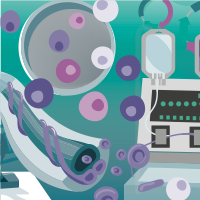Developing and implementing a supply chain management system for cellular therapy programs
Cell & Gene Therapy Insights 2020; 6(2), 325–337
10.18609/cgti.2020.042
The past few years have seen explosive growth in the development of cell and gene therapy drug candidates for oncology and genetic diseases. There are currently 17 approved Cell and Gene therapy products as listed by the US FDA (FDA Approved Cellular and Gene Therapy Products). Current and pending approvals of immune cell products in particular (CAR-T, Dendritic, hematopoietic stem cells) have driven substantial demand for increased cell manufacturing technologies and capacity. Additional advancements in iPSC-derived cell-based therapeutics (nerve, bone, skin, cartilage, bladder, cardiac, liver tissue repair and regeneration) are also driving the development of cell manufacturing technologies. The combined growth and demand for increased production capacity has led directly to an increased need for raw materials, facilities and services. The raw material and product supply chain is a critical element of a manufacturing program for cell therapies. The development and implementation of a robust supply chain management system (SCMS) is required for the successful development of any cell therapy platform. An SCMS is the collection of policies, procedures and tools used by manufacturers to define, control and document the flow of materials into and out of manufacturing campaigns. The main purpose of SCMS is to ensure the provision of an uninterrupted supply of clinical materials that meets all regulatory requirements as per the Code of Federal Regulations 21CFR§210,211 Good Manufacturing Practices (GMP). The SCMS must include identification and specifications for raw materials as well as sourcing and qualification of all providers of raw materials and services. It, also, must provide for documentation on procurement, shipping, holding, testing and product distribution with traceability throughout the process and tracking of process intermediates and final drug product. The system must reliably capture and report out supply chain data in a manner that supports continuous cell manufacturing and future process planning and optimization (e.g., materials mass balance). In this piece we highlight the major components of a successful SCMS and give examples of approaches for supply chain management that help to facilitate control and compliance, reduce risk and ensure the continuity of clinical materials production.
